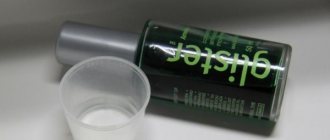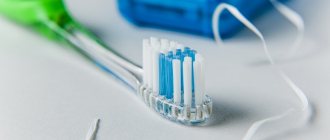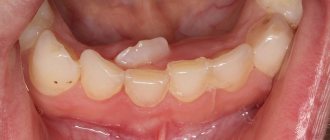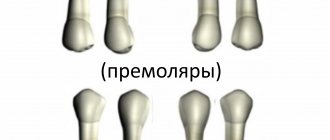Have you already met the tooth fairy, who brings you a coin for a lost baby tooth? Sleepless nights are over, your baby pleases you with twenty temporary teeth and you are starting to think about when to expect permanent ones? Let's try to figure it out when baby teeth fall out
, what you need to remember and what to pay attention to when your child changes
baby teeth
to permanent ones.
How it all happens
First of all, a little anatomy. Baby teeth are formed in the prenatal period, but the formation of permanent teeth begins after the baby is born. Thus, when you rejoice at the first tooth that has erupted, its replacement is already waiting in the wings. The time and order of eruption of permanent teeth, as well as milk teeth, is individual for each child. But temporary teeth fall out in approximately the same order as they appeared. The permanent first molars appear first. There is no milk analogue for these teeth, because in a small child’s jaw there was simply not enough space for them. The baby grows, the gaps in the dentition increase and the first adult teeth appear in the mouth - the so-called “sixes”. After the molars have erupted, it is time to replace the baby teeth with permanent ones. Loss occurs, as a rule, in the same order as appearance.
When does radiography come to the rescue?
Very rarely, but still situations occur in dental practice when even the doctor doubts which tooth he has to work with - a child’s or a molar. In this case, the capabilities of radiography are used. In the photographs you can see:
- length and structural features of the roots;
- presence/absence of radical primordia;
- the location of the unerupted unit and the direction of growth of its incisal edge.
If you need to find out exactly what the situation is with a change in bite in a child, contact your dentist. He will tell you the number of units that should fall out in the near future, and tell you whether it is worth interfering with this process.
The procedure and timing of changing baby teeth to permanent ones
When does it make sense to wait for the first permanent teeth to appear? As we said above, the first molars to erupt are the teeth that are not included in the primary set. This happens around the age of six. The next ones to wait for are the front teeth, which displace the milk teeth. Tooth loss in children
It begins with the temporary root gradually resolving, making room for the permanent tooth. The baby tooth becomes loose, falls out, and very soon your child will be able to boast a real, adult set of teeth.
Care instructions
Molars in children require even more careful care than in adults. Frail enamel is much more susceptible to the effects of carious bacteria and the external environment, and the love of sweets and carbonated drinks does not add strength to it. When children develop a permanent bite, parents need to take special control of oral hygiene and diet (at least until the age of 14–15, when the teenager himself begins to realize the importance of dental health). In general, there are no difficulties here: in order to keep children's teeth strong and healthy, you need to follow several basic points.
- Daily hygiene.
Brush your teeth at least twice a day, use dental floss and special rinses. - Proper diet.
Limit your intake of sweets and carbohydrates. - Preventative visits to the dentist at least once every six months.
If necessary, fluoridation and sealing of molars in children (so-called fissure sealing). - Do not forget to wear a protective mouth guard during active games and sports.
Tooth loss chart
Here is an approximate order of loss of temporary teeth, which is preceded by the resorption of their roots:
- the roots of the upper and lower central incisors begin to decrease from 4-5 years. As a rule, this process lasts about two years and they fall out by the age of 6-7 years;
- the upper and lower lateral incisors become loose from the age of six and their permanent analogues should be expected at the age of 7-8 years;
- The first molars above and below can be prepared for replacement within three years. The process of root resorption begins at the age of 7 and permanent ones appear by the age of 9-11;
- next in line are the upper and lower canines. The root dissolves starting at the age of eight and children show off new fangs by the age of 9-12;
- The second molars complete the process of tooth replacement. Baby teeth will fall out around the tenth year of life.
What is the process of changing teeth?
The process of changing teeth in the human body is laid down at the genetic level—twenty teeth are enough for small children to chew food well. After the age of five, a period of active growth begins, the jaw enlarges, gaps appear between the baby teeth, which are subsequently filled with permanent teeth.
Unlike teething, the process of changing baby teeth to permanent teeth does not cause discomfort to the child. The roots simply dissolve, after which the teeth fall out under the pressure of their “brothers” growing from below. The peculiarity of newly grown permanent teeth is that they do not have a fully formed root - this takes about three years.
Despite the fact that in most cases the process does not require outside intervention, parents should keep it under strict control. Once a week it is necessary to examine the child’s oral cavity - from about the age of five, the baby’s teeth seem to thin out, and subsequently begin to become loose. Having noticed this phenomenon, you can begin to gradually loosen your teeth so that they come out of the gums more easily.
Timing of permanent teeth eruption
Permanent teeth in children erupt in the same order as baby teeth:
- central incisors above and below: permanent teeth appear in first-graders - at 6-7 years from below and at 7-8 years from above;
- the lateral incisors on both jaws change to permanent ones at 7-9 years of age;
- permanent first premolars appear by 6-11 years, and second ones should be expected no earlier than 10-12 years;
- at the age of nine to twelve, the upper and lower canines appear;
- The appearance of molars usually begins at the age of six and ends at the age of 21, when the third molars erupt.
Please note: the information above is approximate, and if your baby's teeth are not appearing on schedule, there is no reason to worry. In some children, permanent dentition forms earlier, in others - later. In any case, by the time they reach adulthood, most teenagers can already boast a full set of permanent teeth, and all that remains is to wait for the “eights” - wisdom teeth. However, more and more often, recently, wisdom teeth do not appear at all, as they are rudimentary and practically do not participate in the chewing process.
Doctors are our pride
We did the research and found out why they trust us. In reviews
On our website, parents note the highly qualified doctors who have knowledge of several related areas and have extensive experience
working with children
. This allows you to see the clinical picture as a whole and plan treatment correctly.
In 2021, family dentistry "DOMOSTOM" in Domodedovo entered the TOP 100 private children's dental clinics in Russia according to the rating of the expert magazine about dentistry Startsmile with the support of Kommersant Publishing House
Our clinic’s team of professionals knows how to help your child. Sign up for a consultation with us. Attentive doctors will tell you in detail about the condition of the baby’s oral cavity and answer all questions.
Early tooth loss
The time of tooth loss depends on the individual characteristics of the child’s body. However, premature tooth loss can be dangerous. The thing is that if a baby tooth is missing for a long time, then the neighboring teeth move, and there is simply no room left for the permanent one, which begins to grow in due course. This situation can cause a violation of the correct bite, distort the dentition and require long-term treatment by an orthodontist.
What causes premature tooth loss in children:
- various injuries;
- periodontal diseases;
- caries;
- infectious diseases suffered by a child in preschool age.
If a baby tooth has fallen out, and its permanent replacement is not expected soon, consult a dentist. In modern dentistry, there are special designs - plates that do not allow neighboring teeth to move and preserve space for a permanent tooth. Such systems do not injure tooth enamel, do not involve grinding of teeth and do not interfere with the baby while talking and eating.
Common problems with molars in children
| Problems with molars | How to fix? |
| Molar tooth is loose | A common occurrence with injuries and bruises. To avoid tooth loss, an urgent visit to the dentist and the application of a special splint are necessary, especially if the child’s molar sways when touched. |
| Broken molar tooth | Severe chips may require orthopedic treatment. If a child's front molar has chipped, aesthetic restoration with veneers or crowns may be required. |
| Molar caries | When the first molars erupt, it is important to prevent the occurrence of caries. If this happens, then it is necessary to stop the disease in its infancy, otherwise it will affect the deeper layers of the tooth. |
| A child's molar has fallen out | The most unpleasant thing that can happen. If a child knocks out a molar along with the root, then there is a chance to save it. To do this, you need to place the knocked out tooth back into the oral cavity, saline solution or into a glass of milk and urgently rush to the dentist (you need to do it within 30 - 40 minutes after the injury). If a child’s molar tooth has been removed, then there is only one way out - installing a prosthesis. |
Delay in loss of primary teeth
Your child is finishing school, but some of his baby teeth have not yet been replaced by permanent ones? It is worth making an appointment at a dental clinic. Temporary teeth that remain in their places for too long are a sign that there are disturbances in the functioning of the child’s body.
Late tooth loss can be caused by:
- abnormal location of the permanent tooth germ;
- regular stress;
- malnutrition and lack of vitamins and microelements;
- chronic diseases.
Do you want your child to have straight and healthy permanent teeth? Do not neglect preventive examinations at the dentist twice a year.
What not to do?
The following rules will help you avoid bite problems and the appearance of various defects:
- do not allow your child to loosen his teeth if they are not yet going to fall out and are firmly in place;
- teach your child not to touch a loose tooth with dirty hands (and, of course, he should not pick the hole when the tooth has just fallen out);
- Do not give your child a lot of solid foods during the period of bite changes. This way he can break a baby tooth;
- do not fill the hole after tooth loss with alcohol;
- You shouldn’t make fun of your child’s temporary toothlessness.
What to do if your teeth are uneven
Later or premature loss of baby teeth, individual characteristics of jaw development, trauma and many other factors lead to disruption of the position of the teeth. There is no need to worry too much if the emerging permanent teeth do not form a perfectly even row. Contact your orthodontist. Modern dental technologies make it possible to achieve a perfect smile with the help of braces or aligners. A child's jaw is still in the process of formation. Timely treatment is the key to quick and high-quality results.
Reasons for late eruption
Normally, after a baby tooth falls out, it takes 1-2 months for the permanent tooth to erupt. This is the longest period. In most cases, the rudiments of a permanent tooth can already be seen at the site of the lost tooth.
But, if a child’s toothless smile persists for 3 months or more, then this is a cause for concern for parents.
Let's consider why such dental pathology occurs:
- Retention
– a common condition that mainly affects the incisors and canines. They cannot erupt due to dense gums or because they rest against neighboring teeth. There are complete and partial retention. With the full form, a healthy root is visible in the picture, but it is completely under the gum. With partial retention, only part of the crown is visible. In this case, surgical assistance is required.
- Edentia
– a congenital pathology in which there is a lack of rudiments of permanent dental units. Can be complete or partial (sparse teeth). A rare disease. Orthopedic treatment is required as early as possible.
- Impact
– delayed eruption in this pathology is associated with a mechanical obstacle, that is, the child has a supernumerary of dental units. In this case, the permanent root simply does not have room to erupt. Impaction can only be detected using a panoramic x-ray of the jaw.
The sooner the child is examined by a doctor, the higher the chance of having an even and complete dentition.
What should parents do?
Losing primary teeth is a completely natural process and most often it is not accompanied by pain or complications. Nevertheless, in order to be sure of the baby’s health, you should follow a few simple rules:
- The teeth should fall out on their own. Do not pull out a tooth that has begun to loosen - you may accidentally damage a root that has not yet completely resolved and it will remain in the gum. You can help a tooth only if it really “hangs by one thread.” It’s even better if the tooth is removed by a pediatric dentist;
- After a tooth falls out, the wound may bleed. Give your baby a sterile gauze swab and ask him to bite down firmly - the bleeding will stop in a few minutes. Try not to feed your child for a couple of hours after losing a tooth. For the same period, you should give up hot, sour and salty foods;
- When changing teeth, it is very important to visit the dentist once every six months for preventive examinations. Your doctor will assess the general condition of your teeth and give recommendations on how to care for your baby and permanent teeth;
- Even though baby teeth are temporary, their condition must be treated very carefully. The health of temporary teeth directly affects the health of permanent teeth.
With each new permanent tooth, your child becomes more mature. Attentive attention to oral hygiene and regular dental checkups can give your child one of the main decorations: a healthy and beautiful smile.
Symptoms that indicate that the process has begun:
- Some children experience an increase in temperature (up to 38). In this case, you should not hesitate; it is better to seek advice from your doctor.
- Unpleasant sensations in the gums.
- The space between the teeth increases.
- The roots begin to dissolve (The roots of baby teeth are much shorter than those of permanent teeth. When the process reaches the neck, a tooth change occurs).
- Gums are bleeding.
Classification and purpose of teeth
As a person grows older, the dental apparatus first includes temporary, then permanent units. When the first ones fall out, the root chewing organs grow in the same place. Depending on where they are located, their function and shape are different.
- The incisors are located in the middle of the row. They have a single root as well as a cutting edge. Their shape is flat. The frontal organs are involved in biting food. They do not perform chewing functions; they cannot bear heavy loads. If the crowns are crooked, orthodontics deals with the correction of the dental anomaly. When the frontal unit is lost, not only does a cosmetic defect appear, it makes it difficult for a person to bite off food.
- The canines grow behind the incisors. Their task is to tear off rough and tough parts of food. They, like the incisors, are single-rooted. The root of such units is powerful. This makes it possible to cope with significant loads.
- The small molars, or premolars, are located immediately behind the canines. They have a large crown. With its help, a person not only grabs food, but also tears it off and chews food. Many premolars have one root.
- Wisdom teeth grow behind the small molars. The third molar can appear not only at 20 years old, but even at 30 and 40. It happens that wise units are missing. Molars crush and grind food. The upper organs usually have 3 roots, the lower ones - two. It happens that the number of roots reaches four or five.
In appearance, the permanent units are much more bumpy than the milk units. The roots of the indigenous organs are narrow. The anatomical structure is also different. Temporary crowns have thinner walls. The lateral surface of enamel and dentin does not exceed one millimeter in thickness.
Why do temporary teeth fall out?
The process of changing elements of the dentition does not happen just like that. The appearance of the first teeth occurs between the ages of 6 and 9 months, when children begin to eat not only mother's milk, but also denser foods. At the same time, the dimensions of the maxillofacial apparatus are small, and therefore the dimensions of the first teeth are quite compact. Over the years, primary teeth are no longer able to perform chewing functions properly, and the jaw enlarges. As a result, it is able to accommodate all molars.











